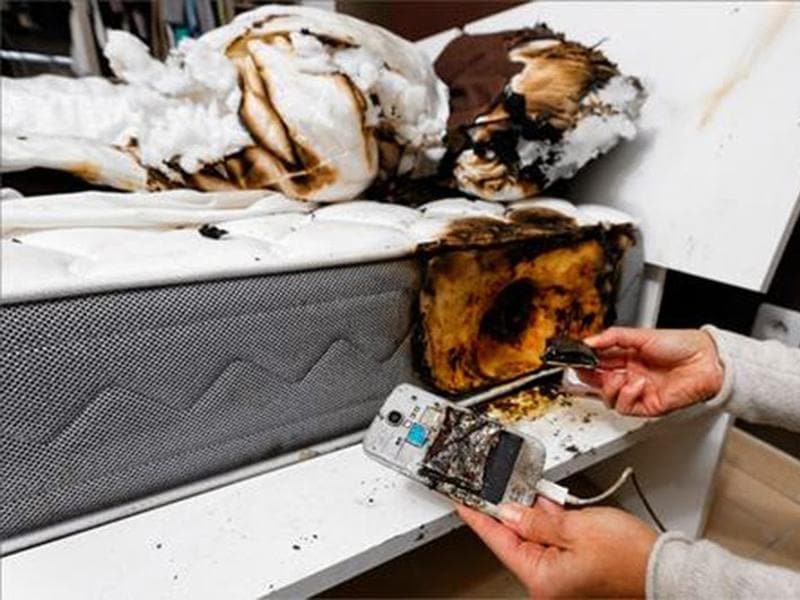Why are so many smartphones exploding?
But why are smartphone batteries exploding now? Scientists and researchers seem to point in the direction of heat/thermal management on the device and also high usage of devices these days.


Twitter has been lately abuzz with consumers crying foul about their exploding smartphones.
The latest casualty was a Reliance LYF smartphone owned by a Kashmiri youth. Tanvir Sadiq, who is political secretary to the National Conference, took to Twitter to put up pictures of the burnt device and say he and his family had a narrow escape.
Another consumer also took to Twitter to report about his burnt OnePlus One, and said the phone exploded while it was being charged. In fact, Indian aviation regulator DGCA banned Samsung phones on flights two months ago after reports of Note 7 blasts followed by a Note 2 explosion.
But why are smartphone batteries exploding now? Scientists and researchers seem to point in the direction of heat/thermal management on the device and also high usage of devices these days.
How do these batteries work and why do they catch fire?
A lithium-ion battery is a kind of rechargeable battery that uses different materials, one holding positive ions and the other holding negative ions. Called the cathode and the anode respectively, these ions move one way when charging, and back again when discharging — being used.
These two layers — or conductors — are never supposed to touch; so manufacturers insert separators to keep them apart. The chemical reaction that makes batteries work creates heat. Overcharging the packs — or charging them too fast — can lead to fires.
Has this happened before?
Yes. Battery fires have been reported in products, including Sony Vaio laptops, last year's must-have toy the hoverboard, electric bikes and even Boeing's Dreamliner jet. Apple has also been victims of such claims, as isolated incidents of iPhones exploding have been reported from time to time. Cases of exploding batteries continue to emerge, as users claimed a burning device damaged a hotel room in Australia early this September or set a car on fire in the US a week later.
How extensive is the problem?
Not very. Millions of lithium-ion batteries are produced annually with a tiny fraction of those catching fire or exploding.
"It's not easy to know if Samsung's problem is the same as others...at this point," Hideki Yasuda, an analyst at Ace Research Institute in Tokyo, said. "If its battery suppliers sell these same ones to other producers,it could possibly affect them too."
What does this mean for gadget-makers that use these batteries?
The battery explosions will put pressure on gadget-makers to figure out how to make battery packs safe for ever smaller devices. "We always want batteries to be safe but also to be more efficient," said Guy Marlair, a France-based safety expert. "The more we boost the battery's performance, the higher the energy density in a small space and the tougher it is to manage security."
This holds true for most smartphones that are being sold today, as handset-makers look to address battery backup in devices while maintaining a good design. Interestingly, Apple, in spite of criticism from analysts, has not increased the size of its battery by much.
"We've already achieved almost 90 percent of the maximum battery life theoretically possible from the lithium-ion battery" Lynden Archer, a materials scientist at Cornell University told The Verge. This is why manufacturers are pushing the limits more and more to eke out only a little bit more energy, he added.
"There's been a bit of an arms race where every manufacturer of a smartphone wants to get the highest battery life," he explained. "This trend in the field is producing more and more of a tendency for overcharging. So, all these models of failure are becoming more commonplace."
Why now and so many cases?
The battery is like a rubber band, Dan Steingart, a materials scientist at Princeton University told The Verge. "When you are charging the battery, you are stretching the rubber band; when you are using it, you are releasing it. Just like a rubber band can break if you stretch it too much, putting too much energy into one side will ruin the battery."
Fast charging could also be a problem. If the charger is incompatible with the battery, the battery can also short out. This can be avoided by making sure the charger and the battery are meant to work together or rather use the set that comes with the box.
Another kind of failure might occur when companies try to make batteries that store more power by increasing voltage. The higher the voltage, the more power there is in the battery, so manufacturers try to pump this up by adding elements like nickel to the lithium. But — again — the higher the voltage is, the more likely the electrolytes are to combine in a way that makes them catch fire.
Reportedly, some scientists are trying to develop a kind of electrolyte that won't burst into flames as easily. "These electrolytes, called ionic liquids need a lot more heat to form flammable gas," Surya Moganty, a chemical engineer who is the chief technology officer of Nohms Technology, was quoted as saying.
(With agency inputs)
Catch all the Latest Tech News, Mobile News, Laptop News, Gaming news, Wearables News , How To News, also keep up with us on Whatsapp channel,Twitter, Facebook, Google News, and Instagram. For our latest videos, subscribe to our YouTube channel.


























